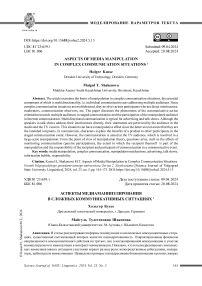Aspects of media manipulation in complex communication situations
Автор: Kusse H., Shakenova M.
Журнал: Вестник Волгоградского государственного университета. Серия 2: Языкознание @jvolsu-linguistics
Рубрика: Моделирование параметров текста для разработки систем искусственного интеллекта
Статья в выпуске: 5 т.23, 2024 года.
Бесплатный доступ
The article examines the forms of manipulation in complex communication situations, the essential component of which is multidirectionality, i.e. individual communicative acts addressing multiple audiences. Since complex communication situations are multidirected, they involve various participants who are direct interlocutors, moderators, communication observers, etc. The paper discusses the phenomena of the communicative action orientation towards multiple audiences in staged communication and the participation of the manipulated audience in Internet communication. Multidirectional communication is typical for advertising and talk shows. Although the speakers in talk shows address their interlocutors directly, their statements are perceived by the audience in the studio and the TV viewers. This situation can have a manipulative effect since the latter are not aware that they are the intended recipients. In commercials, characters explain the benefits of a product to other participants in the staged communication event. However, the communication is aimed at the TV audience, which is involved in a large-scale manipulation. From the point of view of manipulation theory, questions arise, such as the effects of monitoring communication (passive participation), the extent to which the recipient themself is part of the manipulation and the responsibility of the recipient and participant of communication in a communicative event.
Media manipulation, complex communication, manipulation mechanisms, advertising, talk shows, information bubble, responsibility
Короткий адрес: https://sciup.org/149147490
IDR: 149147490 | УДК: 81’23:659.1 | DOI: 10.15688/jvolsu2.2024.5.13
Список литературы Aspects of media manipulation in complex communication situations
- Bondi Paganelli M., 1990. Off-Air Recordings: Wat Interaction? The Case of News and Current Affairs. Rossini Favreti R., ed. The Televised Text. Bologna, pp. 37-68.
- Burger H., Luginbühl M., 2014. Mediensprache. Ein e Ei nfüh rung in Spra che und Kommunikationsformen der Massenmedien. Berlin, Boston, De Gruyter. 532 S. DOI: https://doi.org/10.1515/9783110285925
- Hoffmann E., 1997. Sekundäre Werbekommunikation in Rußland. Winer Slavistisches Jahrbuch, Bd. 43, S. 77-86.
- Hoffmann E., 1999. Sekundäre Werbekommunikation. Zu Grundstrukturen und persuasivem Prozeß in der Wirtschaftswerbung im Russischen. Hoffmann E., Doleschal U., Hrsg. Linguistische Beiträge zur Slavistik VI. München, Otto Sagner, S. 69-87.
- Jäger L., 2004. Wieviel Sprache braucht der Geist? Mediale Konstitutionsbedingungen des Mentalen. Jäger L., Linz E., Hrsg. Medialität und Mentalität. Theoretische und empirische Studien zum Verhältnis von Sprache, Subjektivität und Kognition. München, Wilhelm Fink Verlag, S. 15-42.
- Karabulatova I., 2020. Possibilities of Artificial Intelligence in Assessing the Impact of Potentially Dangerous Texts in Modern News Discourse: Problem of Statement. Published Online: 24 December 2020. International Scientific Forum “Issues of Modern Linguistics and the Study of Foreign Languages in the Era of Artificial Intelligence (Dedicated to World Science Day for Peace and Development)” (LLT Forum 2020), vol. 88. DOI: https://doi.org/10.1051/shsconf/20208801001
- Krämer S., 1998. Was haben die Medien, der Computer und die Realität miteinander zu tun? Zur Einleitung in diesen Band. Krämer S., Hrsg. Medien – Computer – Realität. Wirklichkeitsvorstellungen und Neue Medien. Berlin, Suhrkamp Verlag, S. 9-26.
- Kühn P., 1995. Mehrfachadressierung. Untersuchungen zur adressatenspezifischen Polyvalenz sprachlichen Handelns. Tübingen, Niemeyer. 273 S.
- Kusse H., Shakenova M.T., 2024. Manipulation as a Non-Transactional Perlocution. Bulletin of the Al Farabi Kazakh National University. (In print).
- Kussepova G.T., Karabulatova I.S., Kenzhigozhina K.S., Bakhus A.O., Vorontsov K.V., 2023. Verification of Communicative Types in the Judicial Public Space of Media Discourse in the USA, Kazakhstan and Russia as a Psycholinguistic Marker of Fact-Checking. Amazonia Investiga, vol. 12, no. 61, pp. 131-144. DOI: https://doi.org/10.34069/AI/2023.61.01.14
- McLuhan H.M., 1967. The Medium Is the Massage. An Inventory of Effects with Quentin Fiore, Produced by Jerome Agel. London, Random House. 159 p.
- Petter-Zimmer Y., 1990. Politische Fernsehdiskussionen und ihre Adressaten.Tübingen, Gunter Narr. 323 S.
- Shakenova M.T., Tashimkhanova D.S., Ospanova U.A., Buldybaev T.K., 2020. Leksiko-grammaticheskiye markery manipulyativnosti massmediynogo diskursa (na materiale korpusa russkoyazychnykh tekstov SMI v Respublike Kazakhstan) [Lexical and Grammatical Markers of Manipulativeness of Mass Media Discourse (Based on the Corpus of Russian-Language Media Texts in the Republic of Kazakhstan)]. Nauchnyy dialog, no. 2, pp. 141-160. DOI: https://doi.org/10.24224/2227-1295-2020-2-141-160
- Zhang L., Karabulatova I., Nurmukhametov A., Lagutkina M., 2023. Association Strategies of Speech Behavior of Communicators in Coding Discourse: An Interdisciplinary Approach Towards Understanding the Role of Cognitive and Linguistic Processes in Communication. Journal of Psycholinguistic Research, pp. 1-17. DOI: https://doi.org/10.1007/s10936-023-09966-z


